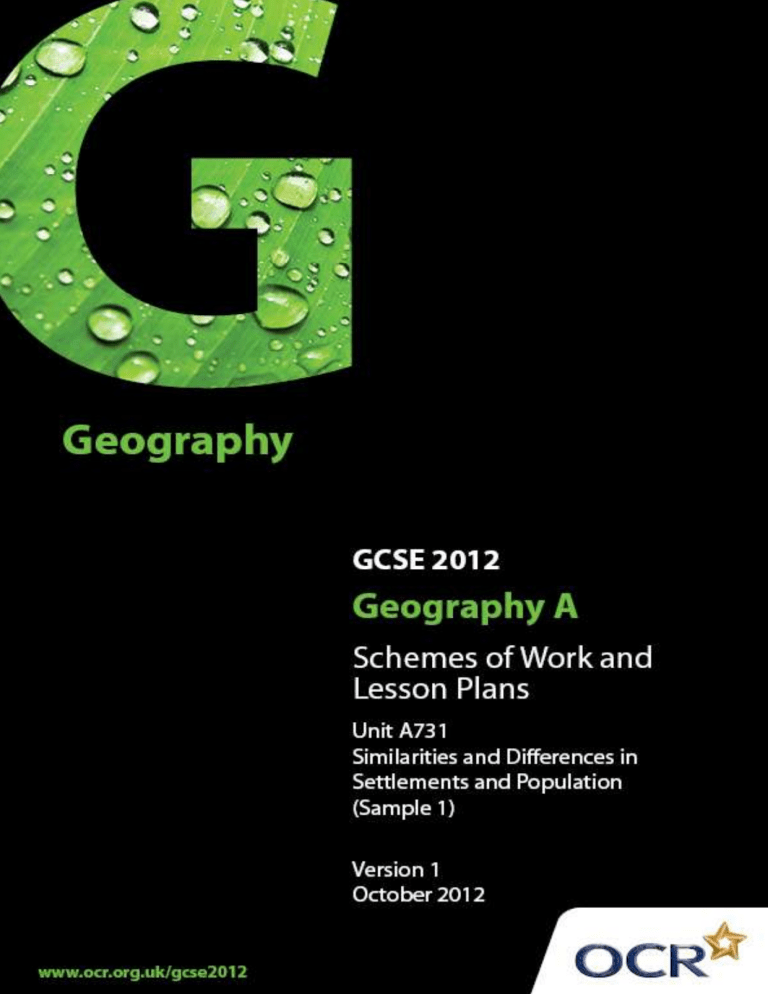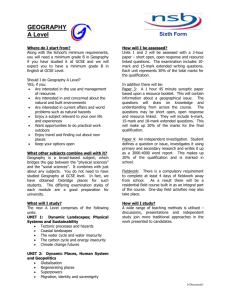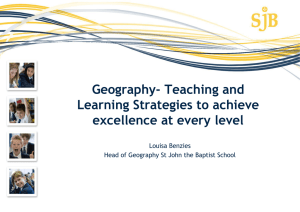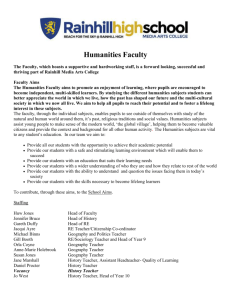Similarities and differences in settlements and opulation

© OCR 2008
Contents
Contents
Introduction
2
3
Sample Scheme of Work: OCR GCSE Geography A - Similarities and Differences in Settlements and Population 4
Sample Lesson Plan: OCR GCSE Geography A - Similarities and Differences in Settlements and Population 11
2 of 11 GCSE Geography A
Introduction
OCR involves teachers in the development of new support materials to capture current teaching practices tailored to our new specifications. These support materials are designed to inspire teachers and facilitate different ideas and teaching practices.
Each Scheme of Work and set of Sample Lesson Plans is provided in Word format – so that you can use it as a foundation to build upon and amend the content to suit your teaching style and students’ needs.
The Scheme of Work and sample Lesson plans provide examples of how to teach this unit and the teaching hours are suggestions only. Some or all of it may be applicable to your teaching.
The Specification is the document on which assessment is based and specifies what content and skills need to be covered in delivering the course. At all times, therefore, this Support Material booklet should be read in conjunction with the Specification. If clarification on a particular point is sought then that clarification should be found in the Specification itself.
GCSE Geography A 3 of 11
Sample GCSE Scheme of Work
GCSE Geography A Unit A731
Contemporary Themes in Geography: Theme 2 – Similarities and Differences in
Settlements and Population
(Sample 1)
Topic: Similarities and Differences in Settlements and Population
Suggested teaching time: 25 hours
TOPIC OUTLINE
1) What types of settlement are there?
2) What are the distinctive features of urban and rural environments?
SUGGESTED TEACHING AND
HOMEWORK ACTIVITIES
Define different types of settlement playing key word bingo. Include conurbation, mega city, metropolis, capital city, city, town, village and hamlet.
Complete settlement hierarchy diagram placing settlements from the
UK into the pyramid. Add chosen non-UK settlement.
Define the urban – rural continuum.
Place local settlements along this continuum.
Complete a local fieldwork study of settlements in chosen UK place, and analyse secondary data including OS maps to look for key characteristics.
Use photographs to analyse key urban and rural land use patterns and highlight the differences between them.
Annotate local maps to see how your chosen location fits these patterns – does this help to place it on the urban-rural continuum?
Compare land use patterns for
SUGGESTED RESOURCES
BBC Bitesize, or other revision websites e.g.
S-cool will have diagrams that can be used.
http://www.geographyfieldwork.org/ruralfieldwork/rurality/stage1.ht
m
Video clip on the BBC Bitesize website.
Class clips video on land use in the city of
Oxford, and rural land use around Loch
Lomond.
POINTS TO NOTE
The chosen local place must be at a suitable scale so that the content for rural and urban areas can be studied and contextualised.
The chosen non-UK place must be a rural or urban environment at a regional scale. Both chosen places, ‘local’ and
‘non-UK’, must not be a country.
This section of the specification provides a good opportunity to conduct some local fieldwork.
4 of 11 GCSE Geography A
TOPIC OUTLINE
3) What are the distinctive features of my UK and non-UK place?
4) How and why does population vary in different places?
5) How does population structure vary between different places?
Sample GCSE Scheme of Work
GCSE Geography A Unit A731
Contemporary Themes in Geography: Theme 2 – Similarities and Differences in
Settlements and Population
(Sample 1)
SUGGESTED TEACHING AND
HOMEWORK ACTIVITIES
MEDC and LEDC locations – why are they different. Could use non-UK location if this is an LEDC.
Use a range of resources pinned around the room relating to landscape and climate of the two chosen locations. These might be images, graphs, tables or descriptions. Ask students to identify which location each resource refers to, and then use the resources to make comparisions between the two destinations.
SUGGESTED RESOURCES
Will depend upon which locations are chosen.
POINTS TO NOTE
Living graph activity of the demographic transition model.
Analysis of graphical data which compares rates of growth and population distribution in different parts of the world.
Annotate population pyramids for countries at different stages of the demographic transition model.
Pairs exercise - match up a range of other pyramids for settlements/countries in a variety of different circumstances.
Thinking through Geography, Leat et al.
National Geographic video on the world population reaching 7 billion might be a good starting point: http://ngm.nationalgeographic.com/7-billion
A range of good resources on population change can be found at http://www.geographypods.com/
GCSE Geography in Focus by Widdowson has a useful section looking at a range of different pyramids.
Centres will want to vary the scales at which they study population issues, from global through to migration patterns in their local area.
GCSE Geography A 5 of 11
TOPIC OUTLINE
6) Why do people move in and out of an area?
7) How and why does development vary in different places?
Sample GCSE Scheme of Work
GCSE Geography A Unit A731
Contemporary Themes in Geography: Theme 2 – Similarities and Differences in
Settlements and Population
(Sample 1)
SUGGESTED TEACHING AND
HOMEWORK ACTIVITIES
SUGGESTED RESOURCES POINTS TO NOTE
Using recent population data, draw a pyramid for UK and non-UK locations
- how do they compare?
Begin section with Mystery activity on
Enrique, the Mexican migrant who tries to hide in a car seat - Use 5Ws technique to build a question bank around migration issues.
Define different types of migration within and between countries including types of migrant and net migration.
Use different case studies to consider reasons for migration including social/cultural expectations and government policies – consider push, pull anchors and barriers for each case study.
Play development top trumps with the class – consider for each measure whether more developed countries have a high or low figure
Brainstorm different development indicators and look at a list of the HDI
– where does the UK and non-UK location stand on the scale?
Analysis of HDI or other composite measures vs GDP/GNP.
Return to DTM used earlier in the
Some resources for this available on SLN.
GCSE Geography in Focus, Widdowson has a number of good case studies which might be used to exemplify some of the issues.
http://www.gapminder.org/ is a fantastic resource for comparing development at a national level. Includes excellent ppt on life expectancy http://www.gapminder.org/downloads/lifeexpectancy-ppt/
GCSE Toolkit: For Richer and Poorer? A study of uneven development.
http://www.geography.org.uk/projects/ks4ict/i dea4/ for an ICT led enquiry into development levels.
6 of 11 GCSE Geography A
TOPIC OUTLINE
8) What do different levels of development look like?
9) What similarities, differences and links exist between a local place and non-UK place?
Sample GCSE Scheme of Work
GCSE Geography A Unit A731
Contemporary Themes in Geography: Theme 2 – Similarities and Differences in
Settlements and Population
(Sample 1)
SUGGESTED TEACHING AND
HOMEWORK ACTIVITIES
SUGGESTED RESOURCES POINTS TO NOTE unit. Students should look at each stage why they might indicate a different level of development.
Play your cards right - compare UK and non-UK location by different meaures of development. Higher or
Lower?
Photographic analysis of countries at high and low levels of development.
Uses image of a shanty underneath high rise apartments as a starter.
Hide part of photo – get students to draw the other half before revealing the shanty town.
Use case studies of indiviudals e.g slum dweller vs City of London worker to compare quality of life for each.
Project led work – produce a poster comparing key features or both UK and non-UK location – this might include; size, function, infrastructure, population, religion and economy.
Poster should also explore links through transport, culture, trade, electronic communication and migration between two locations.
Google images can be used to find the contrast of high rise vs shanty towns, alternatively http://www.geographyphotos.com/ has a good range of photographs which might be used for comparison.
Resources will be determined by choice of locations.
In selecting the non-UK location to study, centres will want to give consideration to the degree and range of links that it has with their local region.
GCSE Geography A 7 of 11
TOPIC OUTLINE
10) What are the alternative futures for a local place and non-UK place?
Sample GCSE Scheme of Work
GCSE Geography A Unit A731
Contemporary Themes in Geography: Theme 2 – Similarities and Differences in
Settlements and Population
(Sample 1)
SUGGESTED TEACHING AND
HOMEWORK ACTIVITIES
SUGGESTED RESOURCES POINTS TO NOTE
Study plans for a future change (i.e. new shopping or housing development) for chosen local place and non-UK place.
Look at different aspects of change through Sustainable development
Venn diagram – consider social, economic and environmental impact.
Some good ideas on the following website http://www.youngpeoplesgeographies.co.uk/
http://en.wikipedia.org/wiki/Sustainable_devel opment
Identify groups who will
manage the change at different scales, including individual, local/community group, local government, national government and international organisation.
Set up a role-play activity to assess potential impacts of change and the different perceptions and opinions about these impacts from named groups.
Homework exam practice – In your opinion how sustainable is the change to …
8 of 11 GCSE Geography A
Sample GCSE Scheme of Work
GCSE Geography A Unit A731
Contemporary Themes in Geography: Theme 2 – Similarities and Differences in
Settlements and Population
(Sample 1)
Topic: Issues in our Fast Changing World – Population Change
Suggested teaching time: 10 hours
TOPIC OUTLINE
1) What is the issue?
Should we cap migration?
SUGGESTED TEACHING AND
HOMEWORK ACTIVITIES
Complete 5W’s activity using BBC news article on the migration cap.
Generate a series of questions which can be used to investigate the issue.
SUGGESTED RESOURCES
http://www.bbc.co.uk/news/uk-politics-
11816979
POINTS TO NOTE
The following scheme exemplifies one possible issue which could be covered, but there are a wide range of choices for this topic.
A ‘recent’ issue relating to population change in the context of this specification is considered to be one occurring within the last five years of the students starting their course.
2) What are the causes of this issue?
3) What are the short- and longterm impacts of this issue?
Give out a series of cards to explain reasons for an immigration cap, complete a Venn diagram classifying reasons as political, socio-economic and environmental factors.
Set up a class debate - Should the
UK have an immgration cap?
Allow students time to research their side of the issue and develop arguments before the debate.
Provide a structure of areas to consider: quality of life, services, resources, environment and population structure.
Homework task – Extended writing task – Will the immigration cap bring more problems or benefits?
http://www.bbc.co.uk/news/10436228 could be a source for the generation of cards outlining the reasons for the cap.
Arguments against: http://www.guardian.co.uk/science/blog/2010/ nov/24/immigration-cap-talent-uk-science http://blogs.channel4.com/factcheck/borisjohnson-says-immigration-cap-risksdamaging-economy/3717
In favour: http://www.conservatives.com/Policy/Where_ we_stand/Immigration.aspx
http://www.migrationwatchuk.org/
Centres should be careful to manage the issues around migration carefully.
Ensure a balanced argument is given.
GCSE Geography A 9 of 11
4) How is this issue managed?
5) How may this issue develop in the future?
Sample GCSE Scheme of Work
GCSE Geography A Unit A731
Contemporary Themes in Geography: Theme 2 – Similarities and Differences in
Settlements and Population
(Sample 1)
Examine how the immigration cap has worked in Australia.
http://www.immi.gov.au/media/factsheets/20planning.htm
Draw up a table of similarities and differences to UK policy.
Ask students to evaluate the success of Australia’s policies on migration.
Look at future projections for population growth in the UK and consider how this will affect arguments over a cap on migration.
Complete a series of What if…… scenarios around migration – with trends increasing, stabilizing and decreasing. Use scenarios to construct consequences diagrams.
http://www.migrationobservatory.ox.ac.uk/site s/files/migobs/Briefing%20-
%20Impact%20on%20Population%20Growth
10 of 11 GCSE Geography A
Sample GCSE Lesson Plan
OCR Geography GCSE A
Lesson title What are the distinctive features of my UK and non-UK place?
OCR recognises that the teaching of this qualification above will vary greatly from school to school and from teacher to teacher. With that in mind this lesson plan is offered as a possible approach but will be subject to modifications by the individual teacher.
Lesson length is assumed to be one hour .
Learning Objectives for the Lesson
Objective 1
Objective 2
To be able to describe specific features of UK and non-UK environments
To be able to contrast the features found at each location
Recap of Previous Experience and Prior Knowledge
Content
Time
5 minutes
5 minutes
30 minutes
10 minutes
Content
Slideshow of a range of landscapes and climate. How can we identify differences in these features of a place?
Show images of both locations – how would you describe the landscape of each.
What are the characteristics of any landscape that we can compare?
Place information about both locations up around the classroom, images, climate data, descriptions, travel blogs etc. Students work as a ‘tag team’, working in pairs, with each taking one location and taking in turns to find specific information about it. This should be summarised in a table that they then share with their partner.
Complete a written answer to the question - what are the similarities and differences in the landscape and climate of the two locations?
Consolidation
Time
10 minutes
Content
Peer assessment of responses. What does a good answer look like? Generate success criteria as a class and then redraft responses.
11 of 11 GCSE Geography A








